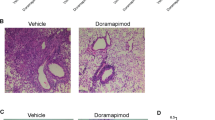Abstract
The immunomodulatory effects of opioids are known in various infections. However, little is known about the effects of opioids in tuberculosis (TB). In the present study, we report the effects of morphine in Mycobacterium smegmatis infection in mice and macrophages. Morphine exerted a dose-dependent suppression of infection in vivo: 50 and 100 mg/kg morphine exerted significant (P<0.05) suppression whereas 5 mg/kg morphine showed no effect. Analogous to the in vivo effects, incubation of M. smegmatis-infected mouse peritoneal macrophages with morphine (100 μM) showed significant reduction in intramacrophage CFU counts. However, morphine did not show any direct antimycobacterial activity in broth dilution assay upto 100 μM concentration. Further, morphine-induced intramacrophage killing of M. smegmatis was abrogated by naloxone and aminoguanidine indicating the involvement of opioid-receptor activation and nitric oxide production in protective effects of morphine. In conclusion, morphine suppressed the progression of experimental TB in both mice and macrophage models.
Similar content being viewed by others
References
Risdahl JM, Khanna KV, Peterson PK and Molitor TW (1998) Opiates and infection. J Neuroimmunol 83: 4–18
Sharp BM, Roy S and Bidlack JM (1998) Evidence for opioid receptors on cells involved in host defense and the immune system. J Neuroimmunol 83: 45–56
Stefano GB, Cadet P, Fimiani C and Magazine HI (2001) Morphine stimulates iNOS expression via a rebound from inhibition in human macrophages: nitric oxide involvement. Int J Immunopathol Pharmacol 14:129–138
Vallejo R, de Leon-Casasola O and Benyamin R (2004) Opioid therapy and immunosuppression: a review. Am J Ther 11:354–365
Mellon RD and Bayer BM (1998) Evidence for central opioid receptors in the immunomodulatory effects of morphine: review of potential mechanism(s) of action. J Neuroimmunol 83:19–28
Fuggetta MP, Di Francesco P, Falchetti R, Cottarelli A, Rossi L, Tricarico M and Lanzilli G (2005) Effect of morphine on cell-mediated immune responses of human lymphocytes against allogeneic malignant cells. J Exp Clin Cancer Res 24:255–263
Sheridan PA and Moynihan JA (2005) Modulation of the innate immune response to HSV-1 following acute administration of morphine: role of hypothalamo-pituitary-adrenal axis. J Neuroimmunol 158:145–152
Singh PP and Singal P (2007) Morphine-induced neuroimmunomodulation in murine visceral leishmaniasis: the role(s) of cytokines and nitric oxide. J Neuroimmune Pharmacol 2:338–351
Singal P, Kinhikar AG, Singh S and Singh PP (2002) Neuroimmunomodulatory effects of morphine in Leishmania donovani-infected hamsters. Neuroimmunomodulation 10:261–269
Singal P and Singh PP (2005) Leishmania donovani amastigote component-induced colony-stimulating factor production by macrophages: modulation by morphine. Microbes Infect 7:148–156
Singh PP, Singh S, Dutta GP and Srimal RC (1994) Immunomodulation by morphine in Plasmodium berghei-infected mice. Life Sci 54:331–339
Durante AJ, Selwyn PA and O’Connor PG (1998) Risk factors for and knowledge of Mycobacterium tuberculosis infection among drug users in substance abuse treatment. Addiction 93:1393–1401
MacGregor RR, Dunbar D and Graziani AL (1994) Tuberculin reactions among attendees at a methadone clinic: relation to infection with the human immunodeficiency virus. Clin Infect Dis 19:1100–1104
Peterson PK, Gekker G, Hu S, Sheng WS, Molitor TW and Chao CC (1995) Morphine stimulates phagocytosis of Mycobacterium tuberculosis by human microglial cells: involvement of a G protein-coupled opiate receptor. Adv Neuroimmunol 5:299–309
Singh RP, Jhamb SS and Singh PP (2008) Effects of morphine during Mycobacterium tuberculosis H37Rv infection in mice. Life Sci 82:308–314
Jhamb SS, Singh RP and Singh PP (2008) A comparison of conventional and radiometric methods for the assessment of antitubercular activity of drugs against Mycobacterium tuberculosis in mouse and macrophage models. Indian J Tuber 55:70–76
Lenaerts AJM, Gruppo V, Brooks JV and Orme IM (2003) Rapid in vivo screening of experimental drugs for tuberculosis using gamma interferon gene-disrupted mice. Antimicrob Agents Chemother 47:783–785
Kaufmann SH (2002) Protection against tuberculosis: cytokines, T cells, and macrophages. Annals of the Rheumatic Diseases 61:ii54–ii58
Rawat M, Uppal M, Newton G, Steffek M, Fahey RC and Av-Gay Y (2004) Targeted mutagenesis of the Mycobacterium smegmatis mca gene, encoding a mycothiol-dependent detoxification protein. J Bacteriol 186:6050–6058
Kaur A, Kinhikar AG and Singh PP (2004) Bioimmunotherapy of rodent malaria: co-treatment with recombinant mouse granulocyte-macrophage colony-stimulating factor and an enkephalin fragment peptide. Tyr-Gly-Gly Acta Trop 91:27–41
North RJ and Izzo AA (1993) Mycobacterial virulence. Virulent strains of Mycobacteria tuberculosis have faster in vivo doubling times and are better equipped to resist growthinhibiting functions of macrophages in the presence and absence of specific immunity. J Exp Med 177:1723–1733
Pierce CH, Dubos RJ and Schaefer WB (1953) Multiplication and survival of tubercle bacilli in the organs of mice. J Exp Med 97:189–206
Sharp BM (2004) Opioid receptor expression and function. J Neuroimmunol 147:3–5
Navolotskaya EV, Kolobov AA, Kampe-Nemm EA, Zargarova TA, Malkova NV, Krasnova SB, Kovalitskaya YA, Zav’yalov VP and Lipkin VM (2003) Synthetic peptide VKGFY and its cyclic analog stimulate macrophage bactericidal activity through non-opioid beta-endorphin receptors. Biochemistry (Mosc) 68:34–41
Navolotskaya EV, Zargarova TA, Malkova NV, Zharmukhamedova TY, Kolobov AA, Kampe-Nemm EA, Yurovsky VV and Lipkin VM (2003) Macrophage-stimulating peptides VKGFY and cyclo (VKGFY) act through nonopioid beta-endorphin receptors. Biochem Biophys Res Comm 303:1065–1072
Pacifici R, Minetti M, Zuccaro P and Pietraforte D (1995) Morphine affects cytostatic activity of macrophages by the modulation of nitric oxide release. Int J Immunopharmacol 17:771–777
Author information
Authors and Affiliations
Corresponding author
Rights and permissions
About this article
Cite this article
Singh, R.P., Jhamb, S.S. & Singh, P.P. Effect of morphine on Mycobacterium smegmatis infection in mice and macrophages. Indian J Microbiol 49, 276–282 (2009). https://doi.org/10.1007/s12088-009-0045-6
Received:
Accepted:
Published:
Issue Date:
DOI: https://doi.org/10.1007/s12088-009-0045-6




